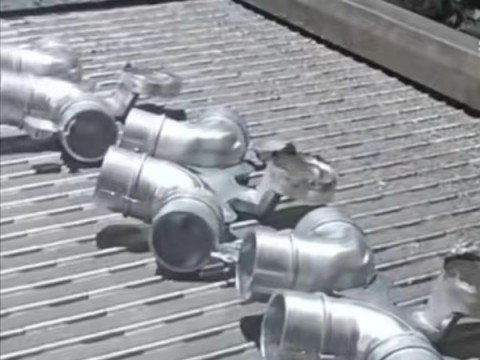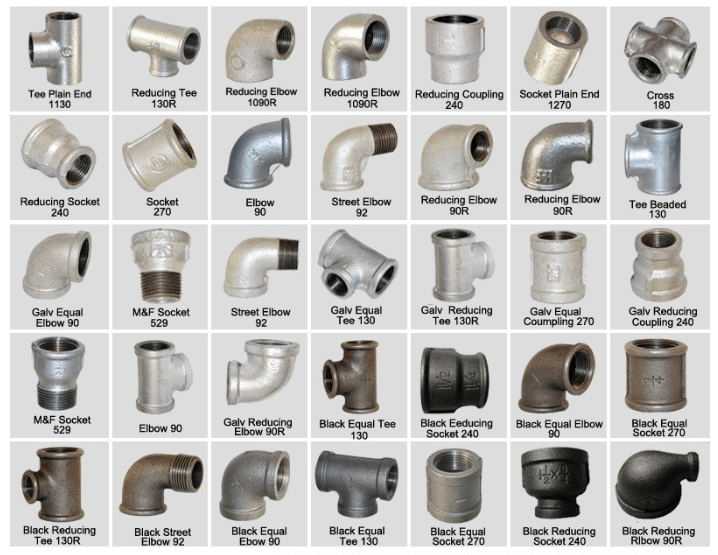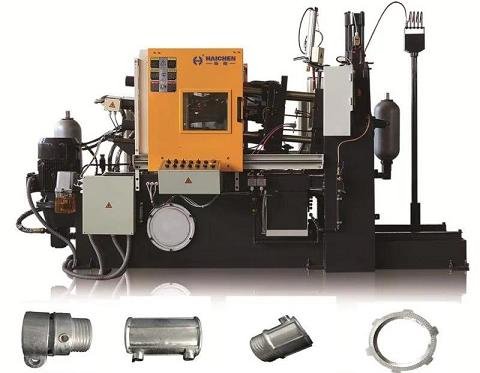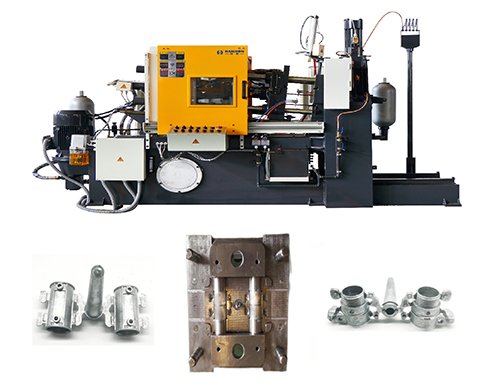Metal pipe fittings different types :
- Elbows
- Tees
- Reducers
- Couplings
- Unions
- Caps and Plugs
- Flanges
- Adapters
- Bushings
- Nipples
Metal pipe fittings are components that connect and manipulate metal pipes in a system.
Common types include elbows, tees, reducers, couplings, unions, caps, plugs, and various types of flanges.
These fittings are used to change direction, join pipes of different sizes, terminate pipes, and create various connections in piping systems.

Metal pipe fittings
Elbows types
Used to change the direction of a pipe run, typically by 90 or 45 degrees.
Tees types
Connect three pipes, with two at a right angle and one at a right angle to the other two.
Reducers types
Connect pipes of different diameters, reducing the flow rate from a larger to a smaller diameter.
Couplings types
Join two pipes of the same diameter, often used to repair or extend pipe runs.

Unions types
Facilitate the connection and disconnection of pipes, allowing for easier maintenance or repair.
Caps and Plugs types
Terminate pipes, either with or without threading, to seal them.
Flanges types
Provide a method for connecting pipes, valves, and other components using bolts and clamps, creating a tight seal.
Adapters types
Used to connect different types of connections, such as threaded to non-threaded, or different thread sizes.
Bushings types
Connect pipes of different diameters, typically used to reduce the size of a larger pipe to a smaller one.
Nipples types
Short, threaded pipes used for connecting fittings or other components.

Different types of metal pipe fittings application scenarios
Petrochemical industry
Flanges and butt-weld elbows: Connect the reactor to the distillation tower and withstand high temperature and high pressure.
Reducer tee: Separates crude oil from refined products, and the material is mostly stainless steel or alloy steel.
Shipbuilding
Flange connection system: Used for fuel and cooling water pipelines, it is required to be resistant to salt spray corrosion (316L stainless steel).
Expansion compensator: Offsets the stress caused by thermal expansion and contraction to prevent pipeline deformation.

Architecture and Municipal Engineering
Threaded joints and mechanical clamping accessories: Quick installation of fire sprinkler systems, suitable for complex layouts.
Galvanized steel pipe elbows: Building drainage systems, balancing strength and rust prevention.
Energy and electricity
Alloy steel tee: Steam pipeline for supercritical units, with a temperature resistance of over 600℃.
Copper tube expansion joint fittings: Refrigerant transportation in refrigeration systems, ensuring sealing and heat conduction efficiency.
The manufacturing method of metal pipe fittings
Die-cast method
Fast-fitting with a special fastening tool (die-casting tool) without the need for high technical skills.
It requires a certain amount of space to operate, but does not require heating equipment, and is suitable for environments with flammable materials.
Insert the stainless steel pipe into the die-casting joint, and use a special fastening tool to die-cast the joint.
To reduce the diameter from the center to the end of the insertion part to realize the connection between the pipe and the joint.
Aluminum alloy die-casting:
Such as 40 diameter aluminum alloy round pipe joints cross cross, Y-shaped tee, etc., these joints are widely used in agricultural irrigation water pipes and other fields.
Type B die-cast zinc-aluminum alloy fittings: including straight and 90 degree elbow fittings, suitable for metal or non-metallic liquid sealing conduits.
These types of die-cast metal pipe joints have their own characteristics and advantages in different application scenarios.
Such as corrosion resistance, high strength, good sealing, etc., and are suitable for various industrial and construction fields.
Metal Pipe Fittings production
Hydraulic cold forming process
Special metal pipe fittings usually adopt the international advanced hydraulic cold forming process, which can ensure that the pipe fittings maintain high precision and high quality in the manufacturing process.
Seamless steel pipe production technology
The manufacturing process of seamless steel pipe includes a variety of methods such as bolt rolling production, continuous rolling production, three-roller rolling production and extruded pipe production.
These processes are suitable for the production of steel pipes with different diameters and wall thicknesses.
Such as bolt rolling production is suitable for structural steel pipes with a diameter of more than 250mm.
While continuous rolling production is suitable for steel pipes with a diameter of less than 168mm.
Cold working technology
Cold working technology is used to strengthen metals and alloys to improve corrosion resistance and quality.
For example, stainless steel materials are becoming mainstream in the oil and gas and medical markets due to their corrosion resistance, formability, and cost-effectiveness.
Titanium tubing offers unique strength, density, and corrosion resistance for use in harsh environments such as aircraft hydraulics, medical implants, subsea equipment, and chemical plants.
Fabrication of special shapes and sizes
Fabrication of specialty tubing also includes the ability to customize special shapes and sizes.
For example, spiral boiler tubes form a rifle-like spiral pattern on the tube through a specially shaped mold to provide a more efficient heat exchange surface.
Fin heat exchanger tubes improve thermal efficiency by creating an extended surface on the surface of the base tube.
Haichen Metal Pipe Fittings Machine
Different types of die-cast metal pipe joints have their own characteristics and advantages in different application scenarios, such as corrosion resistance, high strength, good sealing, etc.
And are suitable for various industrial and construction fields.




